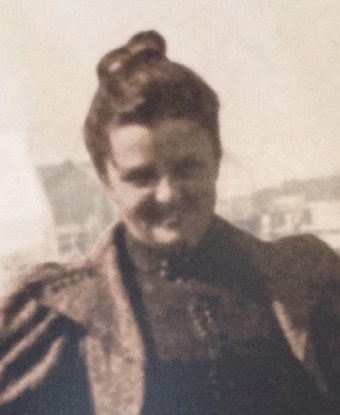Last updated: October 26, 2021
Person
Mollie Brackett

NPS photo/C. Henson
During the top years of the Klondike Gold Rush Mollie Brackett documented her life in Skagway, Alaska through photographs. Her album, once lost, presents many photos of everyday life at home: hanging up the wash, interior and exterior views of their home, picnics, her father-in-law asleep on the couch. She also took photos of the building of the Brackett Road, pack trains on the White Pass, the crowd at City Hall when Soapy Smith’s gang was arrested, Captain William Moore, Alaska natives, gold panning and her family travels to Atlin where they had another store. Her photos of the Fantail Trail are the only ones known to exist of this area.
Though not professional quality, her photos show people in a more relaxed manner. In most of the photos of her husband, Tom, he has a wide grin on his face. There is obvious affection as he turns toward his wife. Another shot shows a relative with a broken jaw from a horse kick. One picture shows “The way we slept at the Summit, six in a bed, July 1898.” All that appears is the inside of a tent with a jumble of blankets over bodies on the ground. She also records dogs, horses (alive and dead), and goats on the White Pass trail and around town. There is even a photo of a big flounder and a shipwreck. Her humor shows when she titles her photographs. One of her and a man is called "Naughty Mary and Old Gust."
There is a photo of Brackett’s Trading Post, which Tom’s brother, Jim, owned and managed. This building evolved into the Boss Bakery. Today it is the Klondike Gold Rush National Historical Park Trail Center.
Born into a musical family in Portsmouth, New Hampshire in 1870, Mary (Mollie) Emmeline Montgomery was a singer, pianist and music teacher. She probably met her husband, Tom Brackett, a Minnesotan, in 1897, when he attended the Boston School of Technology. They married and moved to Minnesota where she taught and sang at the Presbyterian Church.
In 1898 the young couple came to Skagway, Alaska where her husband, Tom, worked for his father, George Brackett, who was a major figure in town. George was building the Brackett Toll Road over the White Pass Trail, one of the passes where stampeders crossed the coastal mountains on their journey to the Yukon gold fields. George Brackett put a great deal of money into the endeavor, hoping for a return on his investment. He encouraged his daughter-in-law to move her inherited investments into his project. He was hopeful of eventually building a railroad over the same trail.
Tom was one of seven sons of George Brackett, a former mayor of Minneapolis. Tom probably helped his brother, Jim, with the Brackett Trading Post. He also packed supplies over the pass for the firm of Hinkle & O’Brien. In Skagway Mollie organized the large household and helped her nieces and nephews.
The story and photographs of Mollie Brackett would be lost to history except for a used car salesman who found her photo album in a repossessed car in southern California. He gave it to a friend who gave it to Alaskan, Pattilyn Drewery, who recognized its value. Because they were kept in the dark in their original album, Mollie’s cyanotypes kept their color and clarity for over a century. To the delight of historians she labeled most of the 3 ½ by 3 ½ inch wide photographs.
Mollie probably took her photographs with a little black box camera called a Kodak Hawkeye Junior which sold for $7.20. Sunlight film cost fifty-five cents. Kodak introduced this pocket camera in 1895, two years before the Klondike Gold Rush. The black grain leather camera measured 4¼ by 4½ by 6 inches and weighed about 20 ounces. It had the ability to do time exposures and held both roll film and small glass plates. Cyanotype is a contact printing process which can be done at home using water and sunlight. While someone else most likely developed her film for her, Mollie probably printed them herself.
George Brackett was never able to make a successful go of the wagon road. The White Pass & Yukon Route railroad bought him out. Tom and Mollie left Skagway in October of 1900. Tom died of typhoid fever the next year. Mollie never remarried. She died at age 69.
Mollie’s photos are available in the book, One Woman’s Gold Rush: Snapshots from Mollie Brackett’s Lost Photo Album 1898-1899 by Cynthia Brackett Driscoll. The information for this article came from this book.
